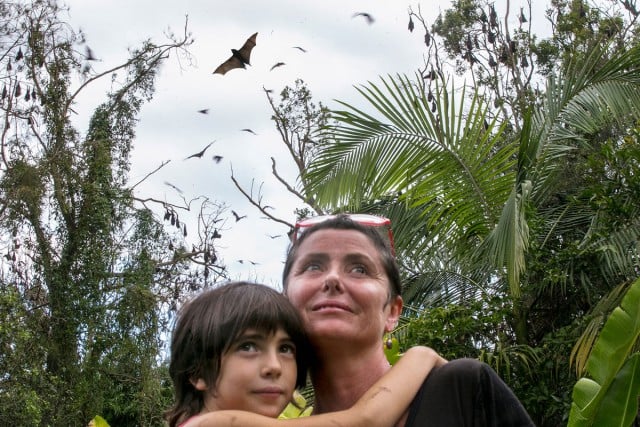
Mullumbimby has bats, lots of them.
And they are starting to become an issue for residents around Palm Avenue and other streets.
If you look to your left while crossing Federation Bridge over the Brunswick River on the way to Main Arm and Coolamon Scenic Drive, you will spot hundreds clinging to the trees.
Mullum resident Lisa Sandstrom, representing the Bat Colony Resident Action Group, says increased numbers of flying foxes in recent years were a result of a relocated colony from QLD, as well as a local relocation from an Ocean Shores colony.
‘There are at least 5,000, possibly many, many more,’ she says, ‘and my neighbours are living with bats a few metres their bedroom,’ she said.
‘This is quite a sensitive environmental issue and we need to be clear that we are not requesting any harm to the colony by relocation or dispersal; we are essentially asking for a long- and short-term Vegetation Management Plan.
Buffer zone
‘A buffer zone created around residents’ homes and and a long-term vegetation management plan could create an area of suitable habitat to attract the colony to the outskirts of town.’
She says, ‘The bats are an issue not just for residents around Palm Avenue, but for Coolamon Scenic Drive, Pine Avenue, Garden Avenue and Chinbible Creek residents too.
‘The list goes on.’
And at last week’s Council meeting, Cr Duncan Dey was successful in gaining fellow councillor support to spend $20,000 on preparing a ‘Plan(s) of Management for bat colony(s)’ within Council’s Operational Plan and Statement of Revenue Policy.
All were in favour except Cr Chris Cubis.
To contact the Bat Colony Resident Action Group, visit their Facebook page.




I sympathise with all the residents. My family and I had a huge colony of flying foxes nesting right on top of us in Ocean Shores. There were up to three different colonies nesting amongst the reserve which our home /backyard faced. We cleaned up to 2 hours every morning and the same every night after the flying foxes departed at night to search for food and then again when they returned to roost during the day at 5am.
The noise, smell and mess was a struggle to cope with on an hourly basis at times. The babies left in the trees overnight (Feb-April) ,while the adults searched for food , was like having a nursery of new born human infants left to cry all night, unattended or comforted. It was at times very stressful and extremely difficult to sleep through. Sleep was deprived and personalities altered. We had young children when they moved in and stayed for 10 years.
We had to build a huge carport to cover most of our outside area to lessen the cleaning of their faeces, food droppings and to protect our cars, deck and windows.
Rain was a nightmare due to the stench afterwards especially if it was summer….
We were told to learn to live with them and they had more rights than us.
Well, it must be inconvenient for home owners.
It’s not easy sharing space with uninvited guests, and if they insist on clear-felling your neighbourhood and every other neighbourhood until the only option left are the street trees in Mullumbimby, where does that leave a flying primate ?
G”)
On asking for help and management National Parks and Wildlife they handed us information on their need to keep the rainforests and nature reserves plentiful. All we could see when we looked outside across the backyard was stripped trees of any foliage and growing flying fox numbers. The smell of their habitat was pungent and at times so overwhelming that we had to close all the windows to create a barrier of “fresher” air to breathe. We made many complaints and tried many ways to deter the flying foxes and were given a warning that distressing the flying foxes would incur a fine. They were protected and we had to live with them.
A steel fence now runs along the back of all the properties that face the nature reserve. It was erected due to domestic animals running through the reserve and disturbing the flying foxes and other animals that resided in there. That was a compromise after NPWS wanted to erect a colourbond fence at 1.8M high and I was adamant I wasn’t going to look at a colourbond fence for the rest of my days.
When I purchased the block of land 20 years prior and there were no flying foxes. No sign of them whenever we visited and stayed on the block of land in our Kombi on the yearly trip we did.
It was purchased for the beautiful outlook in to nature and that I could never be built out, serenity, flat and level and completely privacy. That has changed and the flying foxes have moved on- maybe to Mullumbimby. We have been told they could return anytime… So we enjoy the rejuvenated forest and peace for now.
Thankyou to Lisa, Byron councillors and the Echo for starting this rational discussion on flying foxes in our communities. Flying foxes need trees and by preparing suitable areas for them is a win win situation- particularly as flying foxes are excellent at seed dispersal and are responsible for regeneration of our forests all over the country.
Vegetation Management is the preferred method of control as per the Office of Environment & Heritage’s 2015 Bat Colony Management Plan. Council hopefully will include this issue as an important one and the required funding will materialise. If not, we’re going to have one helluva noisy Summer next year. The colony was particularly noisy and smelly over the last few months…
so they were from a “relocated colony from Queensland.” I suppose that was the dispersed Boonah colony. Must have flown over more than 200 klms of bush just to get as near as possible to another set of humans. Ain’t the bush good enough for them anymore?
I congratulate Lisa and her group for focusing on vegetation management and not relocation, which always involves fatalities. Trish is right bats are our critically important forest regenerators and without them we would have no hardwood forests, no banksias, melaleucas and about 30% of our fruit. Thank goodness for flying foxes! Personally I love them including their aroma and rejoice that we live in a time and place where they still exist. At the rate we are deforesting the land we will drive them to extinction in time – so here’s to doing all we can to protect them while also looking after reasonable needs of humans. After all, they are the natives and we have invaded their land (as Ken so rightly said).
I just hope that people become sufficiently educated about the ecosystem services that bats provide to appreciate them and stop vilifying them for being ‘noisy and stinky’, when we humans certainly are far worse!
A little more information on our situation in Mullumbimby. The Mullum colony has swollen in numbers this year and will continue to do so. We measured the noise coming from the colony day and night with a Db meter over the nursing months of Jan, Feb and March. Residents were living with noise measured at 75 Db. To put this in perspective for you, BluesFest may make noise measuring to 45 Db but only until midnight. Sleep deprivation and loud relentless noise are used forms of torture. Add to this the smell over those hot, wet months and life becomes unbearable. Its impossible to function under such strain.
Yes the Flying Fox are incredibly important to our eco system and a fascinating species. We Need Them. Therefore our approach is a long term vegetation management plan. There is actually plenty of areas along the Brunswick River the Bats could roost and not be a problem to people. For some reason the Bat Colonies are settling in small town communities along the coast. Some suggest the Bats like the street lights but to my knowledge there has been no study into why. This is a problem and just saying Bats were here first and suck it up is not a reasonable response to a growing problem that is affecting many families and will affect the whole town if ignored. Also 300 bats arrived only 5 years ago and now there is over 5000. Do the math we’ll have tens of thousands in a few years and we need to address this.
We have the opportunity to resolve this issue in a way that is harmonious to both Flying Fox and Humans. To pioneer a new environmental way of dealing with this issue. Something must be done to create a livable situation for residents of Mullum and Nature. The Bat Colony Action Group is actually doing something positive for this town and the Flying Fox. It deserves community support. We’ve heard “the Bats were here first” side of the story, got anything practical or positive to go with that stance to help resolve this ever growing problem?
Hi Lisa, this is Indu, I work at the Bangalow Bowlo. I’ve just been trying to track you down because you left your ID at the club. We have it here whenever you can come past to pick it up 🙂